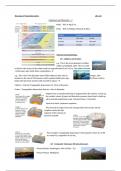Thursday 2nd December 2021 LEC 172
Volcanism and Plutonism – 3
Mafic – Rich in Mg & Fe.
Felsic – Rich in Feldspar Minerals & Silica.
Volcano Geomorphology:
(1) Calderas and Craters:
e.g., This is the 4 km diameter ice-filled
caldera of Sollipulli, Chile. The ice is 650
m thick in the centre of the caldera and has approximately 6 km 3 of ice. The caldera formed
>2,960 years ago. Mafic-felsic compositions.
e.g., This is the 9 km diameter water-filled caldera Crater Lake in Oregon, USA -
located on the site of Mt Mazama, which erupted 6,800 years ago. The floor is 600 m
below the lake level and the walls rise 600 m above.
Caldera = Volcanic Topographic depressions of >1km in Diameter.
Crater = Topographic depressions that are <1km in diameter.
Magma from a chamber/build up of magma below the surface, travels up
the conduit, where if gases and therefore pressure have time to build up,
will eventually explosively erupt. Volcanic Plume + Pyroclasts.
Tend to be felsic, explosive eruptions.
The removal of magma from the storage below the surface via the
eruption causes the top
segment of the volcano to
become unstable
Post-eruption: Topographic depression is left exposed, where it can fill
w/ water/ice, vegetation & soil etc…
(2) Composite Volcanoes (Stratovolcanoes):
< Mount Rainier, Washington, USA (4392m ^ SL).
> Mount Mayon, Philippines
, Conical, steep profile.
Mix between periodic explosive (pyroclastic material) and effusive (lava material) eruptions,
Exploded products are of intermediate-felsic compositions.
They are composed of many strata – many layers of pyroclastic material (lavas).
(3) Lava Domes
< Lava dome at Mount St Helens volcano, USA, 1980-1986
> (Andesitic) Lava dome at Volcán de Colima, Mexico, Nov
2009
Circular Mound-Shaped Protrusion
Collection of intermediate/felsic composition blocking the vent =
circular shaped mound protrusion where viscous material is being very
Steep Sided Plug Slow Extrusion Of slowly pushed up the central conduit towards the surface.
Viscous Lava
To Conduit
They are located w/in a crater but can overflow the boundaries.
Quite often lava domes precede major explosive events – they are very
dangerous.
(4) Shield volcanoes
Low, flatter volcanoes w/ a rounded profile - slopes
of 2-10°.
Composed of low viscosity, mafic lava flows e.g.,
basalt.
e.g., Mauna Loa, Hawaii, USA (Largest volcano)
• >4,000 m high; rises 9,000 m above Pacific floor
• only 17 % volume above sea level
• basalt = low viscosity; slopes <10°
• last erupted in 1984
(5) Fissures
Low viscosity, mafic lava flows rapidly away from fissures, rather
than constructing a volcanic mountain.
1 or a series of dykes which then erupt at the surface, producing
long linear structures at the surface, where magma is erupted.
< Kilaeua, Hawaii, USA, Nov 1979;




